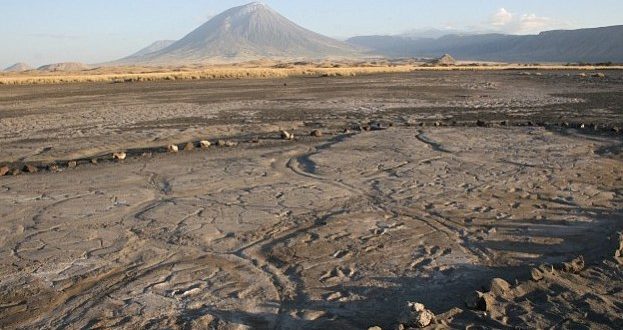Scientists have dated an ancient and incredibly rare collection of footprints on the mudflats beyond the Ol Doinyo Lengai volcano in Tanzania. There are more than 400 footprints at the site, thought to have been left between 5,800 and 19,100 years ago.
A few of the tracks appear to show people jogging through the mud, running a 12-minute-mile pace or faster. Other prints indicate a person with a somewhat strange, potentially broken big toe. Even more tracks show that about a dozen people, mainly women and children, journeyed across the mudflat together, traveling the southwest for an unknown destination. The mud recorded it all-including the muddy drops that fell from their feet with each and every step.
“The first time we went out there, I remember getting out of the vehicle, and I teared up a little bit,” Cynthia Liutkus-Pierce, an Appalachian State University geologist, told National Geographic. “Human origins is a huge interest of mine: where we came from, and why we are who we are. It was definitely emotional to see our own history in this.”
Many Different Kinds of Prints
The discovery is particularly exciting because of the large quantity and variety of prints, which provide a amazingly detailed picture of what life was like for our African ancestors.
“It’s a very complicated site,” said William Harcourt-Smith, a paleoanthropologist at the City University of New York. “There’s one area where there are so many prints, we’ve nicknamed it the ‘dance hall,’ because I’ve never seen so many prints in one place. It’s completely nuts.”
Within hours or days, the mud’s exterior dried up, conserving the prints in a broken crust. A flow of debris buried the footprints a minimum of 10,000 to 12,000 years ago, storing them for later discovery.
A shell discovered in the mud over the footprints made it easier for the team to figure out the youngest possible end of the date range, eventually placing the prints at somewhere between 5,000 and 19,100 years old.
Agencies/Canadajournal

 Canada Journal – News of the World Articles and videos to bring you the biggest Canadian news stories from across the country every day
Canada Journal – News of the World Articles and videos to bring you the biggest Canadian news stories from across the country every day

